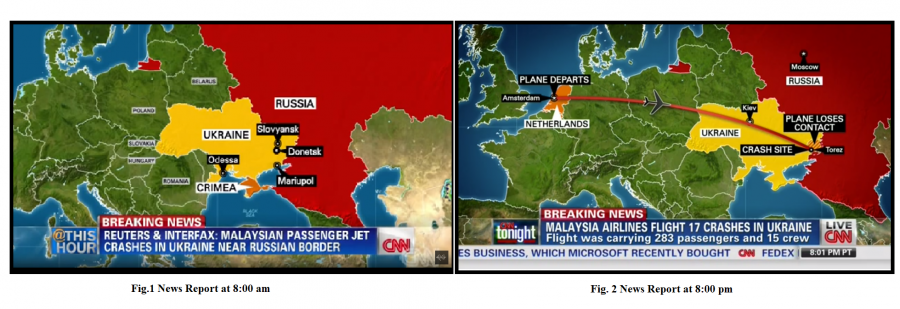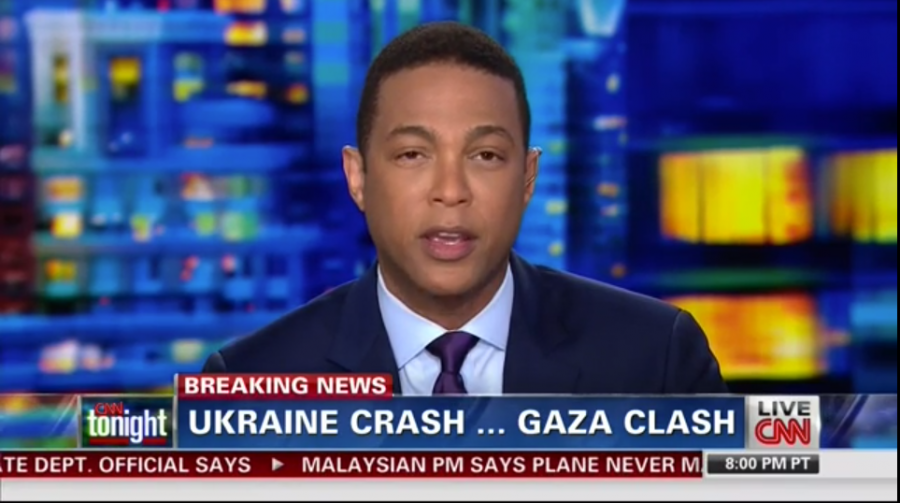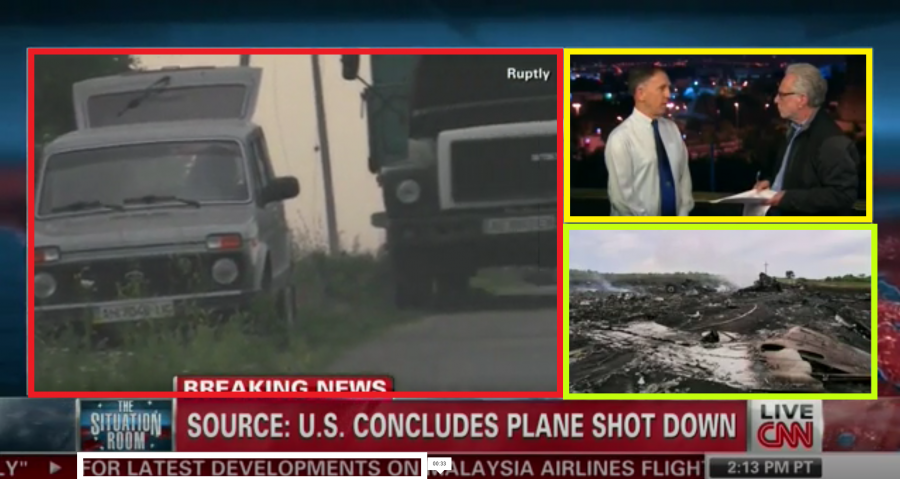
Breaking News: the design of the MH17 crash story
Breaking News! Shock, horror, political turmoil, loss of human life, good versus evil - if we consider these to be the ideal ingredients for the making of an attention-grabbing news story, it is easy to understand why the tragic story of the MH17 flight continues to make it into the headlines and into the ever-important breaking news category, more than five years after the incident took place on July 17, 2014.
CNN and breaking news
When talking about news and mainstream media, there are a lot of topics that emerge. Some talk about fake news and “alternative facts” or debate the effect of news networks on the political and economic environment; in other cases, the discussions revolve around stakeholders and their involvement in news production.
Either way, everything goes back to the notion of news creation. Of course, news creation is not a linear process. It involves a rigorous process of curation based on journalistic judgment and editorial standards of accuracy, and, increasingly, of audience success and impact as well. Furthermore, in this hybrid media environment, one strategic move is to be the first to “break the news”. This raises the question: how are stories designed to be recognized as “big news”?
BREAKING NEWS: The MH17 crash as seen on CNN
The creation of CNN (Cable News Network) in the 80s defined the future of breaking news formats of twenty-four-hours news channels. When others joined the table of non-stop newscasts (FOX News, MSNBC, etc.), the genre of breaking news already had a recognizable format. In other words, CNN set the foundation for the style in which breaking news stories are presented to the broad audience, which developed around the repetition of news on a fixed interval. (Lin & Atkin, 2014)
Each news outlet presents a story in a different way because they have different agendas and perspectives. What they all have in common, is the process of framing a story to make it appealing to their audience, while creating iconicity. This article seeks to answer the question: how are these narratives created? It does so by analyzing how the story of the MH17 tragedy was presented as breaking news on CNN in the United States.
Our research started with watching the first twenty-four hours of reporting on the MH17 crash on CNN, using an online TV archive. We observed the news broadcast on July 17 and started doing our own ‘investigation’; meaning we began asking questions.
How does the breaking news on the MH17 crash start?
In the morning, the CNN audience knew that there was vital information to come because the title ‘Breaking News’ was appearing on their TV-screen in big capital letters. A story started to unfold: According to Reuters and Interfax, a Malaysian aircraft that took off from Schiphol airport (Amsterdam) with 283 passengers and 15 crew members on board, never reached its destination (Kuala Lumpur). The aircraft crashed at the eastern border between Ukraine and Russia. With no further information, the news coverage continues with declarations from an aviation expert.
“We’re going to cover all the angles of the story for you.”
What we observed is that when information is scarce, the narrative is presented through expert speculation. This means using experts as an instrument of legitimacy when there are gaps within the story. Speculation is not the only method CNN uses to create the framework of the newscast. They also use auditory and visual stimulants to reinforce the idea that this coverage of the story is something important, urgent, and worth following.
How are facts made?
There is a paradox between high accuracy standards and sources in breaking news journalism. While, as the audience, you expect news to be well-researched and to come from accurate and trustworthy sources, sometimes this is not the case. In a hybrid media system, news outlets gather and curate images and information from grass-roots sources.
Such was the case in the coverage of the MH17 story. For example, we observed that CNN uses footage from Ukrainian media sources, eyewitness footage, and freelance reporters. Various instruments can be used to create a captivating narrative, one of which is multimodality. Let’s zoom in on how facts are designed with the use of this method.
First, the audience needs to know where this happened. An ideal way to show this is by using a map, because maps create a coherent grammar of visual design. Even if the news outlet has real footage, they can still design these visual schemes to bring forward their perspective. Showing a map that differentiates regions through different colors can have substantial effects.
The big storyline emerges from the question of who did it?
For example, we see that colors are not chosen randomly; they have specific meanings. In the image below, depicting Russia as a red territory is a choice charged with innuendos and indexicality (cold war, communism, danger, etc.). Observing the three colors in reference to identity, we see that the perpetrators, the victim, and the heroes have been identified and differentiated. If Russia was green and Europe was red, then the audience might question CNN’s news reporting credibility. This is how graphic micro-hegemonies influence the readability of texts.
Names also play a part in placing an event geographically. While identifying capital cities in maps is common practice, CNN also highlights conflict areas, like Crimea. This can lead the audience to access their collective memory and relate the story to recent conflicts in the region. As the story evolves and changes, so do the maps: they now have a more coherent representation. All the information you need to know is presented in the updated map, including point of departure, route, the crash site, and of course political actors.

Source: https://archive.org/details/CNNW_20140717_210000_The_Situation_Room/star... (Fair Usage)
Second, the audience needs to know what happened. Here, the strategic choice of words is essential. One characteristic of the breaking news genre is the presentation of descriptive short texts at the bottom of the screen. The function of these words is to provide context and framing.
Breaking news is, by definition, a sensational story, but it needs to be framed in a manner that allows them to be easily recognizable. So, using a phrase like “UKRAINE CRASH...GAZA CLASH” in big capitals letters will have a more significant impact on the audience than providing a more complicated title or no title at all (see image below). This is a process often encountered in news coverage because it creates syntax in which one message suggests coherence with the other, within the dominant frame. (This is also the case for the 9/11 news coverage).

Source: https://archive.org/details/CNNW_20140717_210000_The_Situation_Room/star... ( Fair Usage)
A third method of creating intense interest is by citing sources - of course while using the same format of capitalizing letters: “SOURCE: U.S. CONCLUDES PLANE SHOT DOWN”. This example raises some critical questions: Who is the source? Is this an official statement? How does “U.S.” conclude what happened with the plane? Who has authority over the conclusions of this story?
What we found, while following this story, is that news creators connect directly to the audience’s cognitive capacity to read frames by using certain elements that are easily curated and repeated. If we take a look at the image below, we can observe how all the processes described earlier can be found in a single snapshot.
Besides the -previously discussed- word usage, there are three different visuals that communicate particular messages: military implications (the left half), tragedy (bottom right) and, of course, the need for discussion and debate over this story (upper right). We also observe an incentive to keep our attention focused on the CNN broadcast because they offer the “latest developments”; the story is not finished, it is still developing, and CNN will be the one presenting it to you. And this brings us to another instrument used in breaking news coverage: simulating authority.

Source: https://archive.org/details/CNNW_20140717_210000_The_Situation_Room/star... (Fair Usage)
Going back to the idea of creating identities through sociolinguistic elements, we observed that CNN presents itself from an authoritative position; to quote the news correspondent Jim Sciutto: “We’re going to cover all the angles of the story for you.” This quote also portrays the idea of a gatekeeper of knowledge; the mediator between biased actors (U.S., Ukraine, and Russia) and the audience. We called this a “simulated authority” because it is not something inherited. It is a consensus between CNN (or media in general) and the viewer, so it can always be retracted.
Trust is a crucial element in the relationship between narrative creation and the readability of a text. And here comes another question: are news narratives presenting the objective truth? During our research on the first twenty-four hours of news reports on the MH17 crash, we noticed that emerging rumors were very quickly framed as facts.
For example, a deleted tweet was used to reinforce the idea that Ukrainian pro-separatists had the weaponry to take down the plane from the ground. Below is an image that was shown on the screen. We see an already-curated image because CNN presents someone else’s tweet (maybe also a journalist) that directly frames pro-Russian separatists as the perpetrators. Moreover, the news anchor talks about the type of missile launcher shown in the tweet and the capacity of that launcher to hit a plane at 33.000 feet, concluding that “... that fits, again, with this narrative here, that is what happened”.
Source: https://archive.org/details/CNNW_20140717_210000_The_Situation_Room/star... (Fair Usage)
What does this mean? Live coverage of emerging stories seeks to glue the viewers to their screens. So, when designing a breaking news story, the network needs to feed constant information to the public. Sometimes that information is based only on speculations, but if these turn out to be the truth, then the story will become even more complex and exciting. As we already mentioned, breaking news is “big news”.
How do big storylines emerge?
The big storyline emerges from the question "who did it?" As we’ve presented so far, facts need to be discussed and analyzed to provide answers. We also stated that some information is framed as facts, although it may come from vague or unconfirmed materials. An example of this can be found in the coverage of the story presented during the night-time segment. CNN chief national correspondent, Jim Sciutto, states that U.S. officials confirm that the plane was taken down by a surface-to-air missile. He then provides technical military intelligence evidence to justify the officials’ statement. He points out that although the U.S. confirms this information, they are not willing to jump to any conclusions about who is responsible. Ukrainian officials, however, haven’t hesitated to jump to such conclusions. Sciutto informs us that they have “a fair amount of evidence” to back up their claims.
The audience is then presented with a recording of a phone conversation between what Ukraine alleges to be a pro-Russian militant and a Russian military or intelligence official, in which they discuss having shot down the plane. Afterward, Sciutto uses a dramatic choice of words to state that “...the scenario this paints… is an alarming one, and that is that Ukrainian pro-Russian militants in Ukraine have accidentally shot down a passenger plane. They thought they were targeting a Ukrainian military transport”. Sciutto presents CNN as being objective and impartial by very carefully pointing out that the U.S. officials and CNN are not willing to jump to conclusions and confirm any claims made by Ukraine. He then, however, does not refrain from exposing the audience to the unverified evidence provided by Ukraine, which in effect plays a crucial role in influencing viewer conclusions about who is to blame.
Just by pursuing this single “lead” this narrative transforms itself from a twig to a full-grown tree. If facts present pro-Russian rebels as the “guilty party” then we need to find out how they did it; if facts present that Russia is involved then we need to find out who knew about the events and if they are hiding anything; if Russia is involved then the United States should be involved also, and should perhaps help the counterparty (Ukraine, who pledges their innocence) - these are all subjects that were developed and debated throughout the initial twenty-four-hour coverage. Each small fact is a branch that offers volume to the tree (big storyline). When the branches of a tree start to wither, they are cut down in order to make room for new productive ones. The same thing happens when designing a story to be a breaking news topic.
To this day, the answer to the question of who is responsible for the tragedy of MH17 is still contested. However, as we have seen through the use of various methods, CNN was already directing the audience to view Russia as the likely perpetrator from the time the news broke.
How is breaking news created?
"Big news" does not appear from thin air; it is created with the help of specific instruments that speak to the audience. Repetition plays a vital role in this process. It creates a Pavlovian response in our subconscious. Hearing the same information over and over again makes us believe we should be interested in whatever the news anchor reports. Whether it's a big story or a small one, news are increasingly less about facts and more about entertainment. Even when stories provide more than enough material for designing a breaking news coverage (as in the case of the MH17), we see that repetition and derailment from the main subject are a big part of the narrative. Today, we see that there is an over-saturation of breaking news, making it part of our daily lives, thus defeating the actual purpose of this genre.
References
Cushion, S., (2015). News and Politics: The Rise of Live and Interpretative Journalism. Routledge.
Kille, L.W., (2009). Breaking News Leads, In Journalist Resource. Retrieved from https://journalistsresource.org/tip-sheets/writing/breaking-news-leads/ on 3.10.2019.
Lin, C. A., & Atkin, D. J. (2014). Media Technology and the 24-Hour News Cycle. In Communication Technology and Social Change: Theory and Implications (pp. 143–164). Routledge.
McPhail, T. L. (2010). Global Communication: Theories, Stakeholders and Trends. Wiley Blackwell.